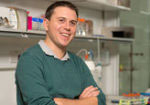

Circadian rhythms are driven by cellular clocks throughout the body. Their function is critical to the daily organisation of human behaviour and physiology which underpins healthy aging. Whilst the circuitry that facilitates circadian transcriptional regulation in mammals is well understood, the time-resolved molecular mechanisms that confer ~24h periodicity are not. 20 years ago the cyanobacterial circadian clock was successfully reconstituted using three recombinant proteins and Mg.ATP, but the apparent complexity of the eukaryotic cellular clockwork has hindered such approaches for mammalian systems. However, recent work has identified a number of conserved proteins, post-translational modifications and protein-protein interactions that appear to be essential for circadian timing in mammalian cells. Drawing on insights from cell culture and comparative chronobiology, this project will employ purified proteins, real-time assays and microfluidics to attempt reconstitution of the mammalian cellular circadian clockwork in solution.
Working within an inclusive multi-disciplinary team, this ambitious project will build on previous work to delineate the biochemical mechanisms that drive daily transitions in cellular state. Techniques will include cell culture, bioluminescence and fluorescence imaging, biophysical approaches, protein purification, live-cell microscopy, quantitative mass spectrometry, transgenic complementation, genome editing, and opto-/chemigenetics.
The successful applicant will have a degree in biochemistry, cell biology or a related area. You should be enthusiastic and creative with good communication, organisational and numeracy skills. Previous experience with tissue culture, protein purification and programming would be desirable but not essential.
If you share our interest in biological timing and would like to work with us, please get in touch to find out more.
References
Nakajima et al, Science, 2005
O'Neill & Reddy, Nature, 2011
Wong & O'Neill, Current Opinion in Physiology, 2018
Stangherlin et al, Nature Comms, 2021
Watson et al, Nature, 2023
Fang et al., PNAS, 2023